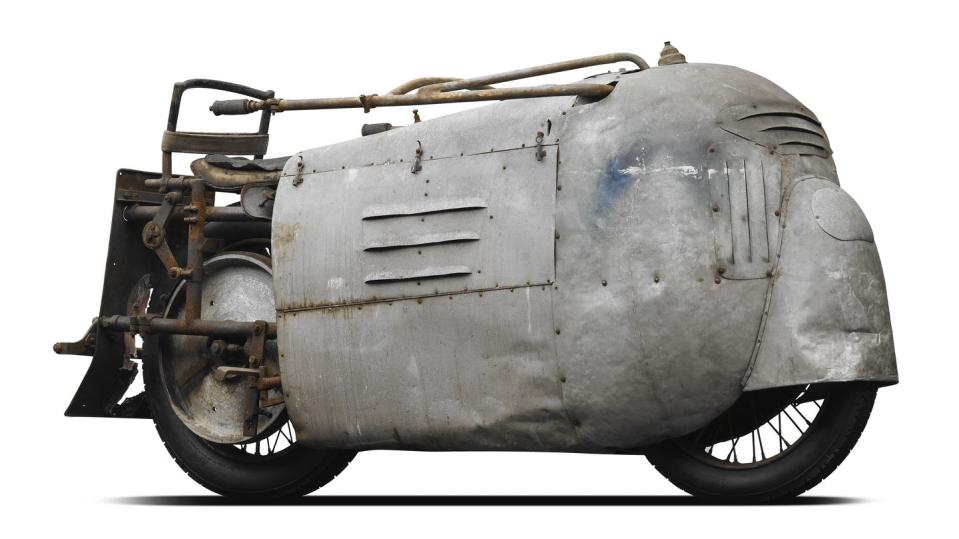The Mullin Closed and They’re Auctioning Everything—Here are Our Favorites
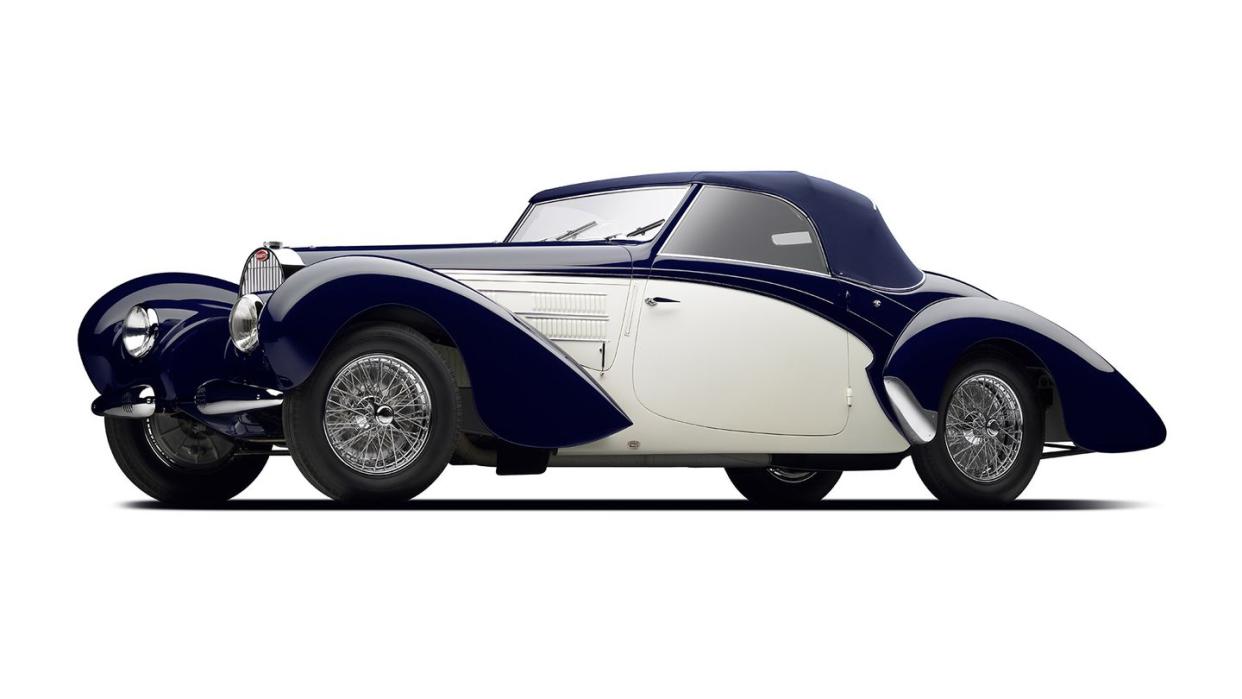
The Mullin Automotive Museum in Oxnard, California, had the greatest collection of beautiful cars ever assembled. There, I said it. And I'm not the only one who thinks that. It was known for beautiful Bugattis, Delages, and Delahayes, but there were also a few funky French cars in there, too.
It was put together by Peter and Merle Mullin, and with the untimely passing of Peter Mullin last year, much of the collection is now up for sale. Four of the Mullin Museum’s most iconic vehicles have already been donated to the Petersen Automotive Museum, of which Peter Mullin had been chairman: the 1937 Talbot-Lago T150 CS “Teardrop,” the 1938 Hispano-Suiza H6B Dubonnet Xenia, the 1939 Delahaye 165, and the 1938 Delahaye 145.
Much of the rest of the collection is now going to be auctioned off by Gooding & Co., which will drive 115 lots over the ramp April 26 at the museum. Here are our favorites.
1938 Voisin Type C30—$150,000 to $250,000
This was the last Voisin ever produced (the Biscuter, made from 1953 to 1960, though designed by Gabriel Voisin, was made by Auto Nacional, SA in Spain). The Type C30 carries many Voisin hallmarks, including the barrel-profiled hood panels, aluminum-trimmed, sharp-edged fender lines, and vertical, flat-panel dashboard. It is truly a thing of elegant beauty. The Type C30 could be had in either stylish coupe or cabriolet form. It would prove to be the marque’s final appearance at the Paris Motor Show, and indeed the last Voisin to bear the storied marque's name. In this final iteration of Voisin, the C30 received a 3.5-liter Graham-Paige engine with a centrifugal supercharger, and a Graham driveline. Imagine walking in to Pep Boys and asking for a water pump gasket for a Graham-Paige. These cars were built under license by Société des Automobiles Voisin following the closure of the Voisin factory in 1936.
While it's not exactly cheap, the expected price is well below what you could pay for some Voisins. So sell your house and register to bid. Bidding paddles are only $200 and get you and a companion in.
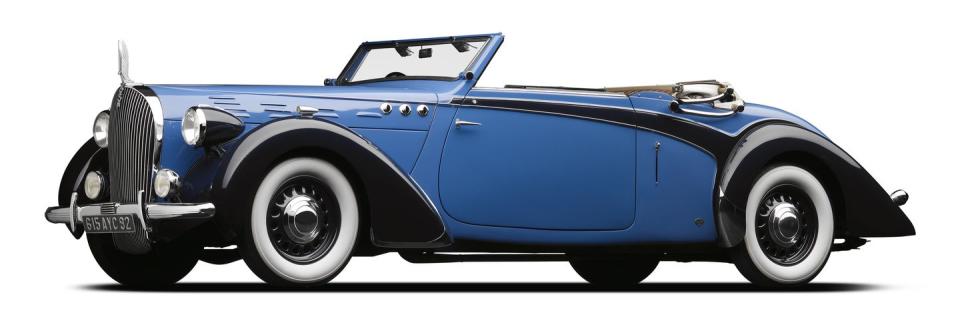
1938 Bugatti Type 57C Aravis 'Special Cabriolet'—$2.5 to $3.5 Million
The Type 57 is widely regarded as the pinnacle of Bugatti excellence. This example is one of only four Gangloff-bodied Aravis Special Cabriolets ever built. Of those, only two were built on the Supercharged Type 57C Chassis.
This one has racing provenance, having been originally sold to Bugatti works driver Maurice Trintignant and raced at the 1939 Grand Prix du Comminges, a pre-FIA Grand Prix that ran 17 miles through the Pyrenees. Trintignant finished 11th.
The Type 57 was powered by a "jewel-like" 3.3-liter twin-cam, straight-eight that represented the ultimate in automotive design at the time. The C in the car's name stands for compressor, or supercharger. It was the third version of the straight eight and made 160 hp, enough to power the cabriolet to over 100 mph. It also got magneto ignition and four-wheel hydraulic brakes, all of which made it one of the fastest and most sophisticated cars of its era. Of 710 Type 57s ever made, only 96 left the factory in supercharged 57C form. This particular 57C received an "exquisite restoration" by Bugatti specialist Sargent Metal Works, good enough that it won first in class at Pebble.
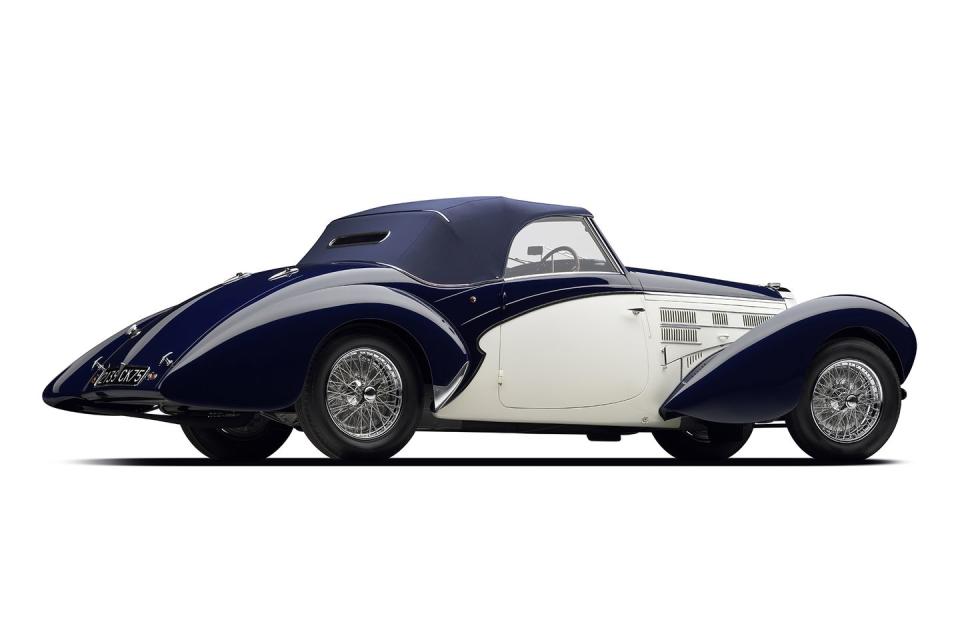
1937 Delage D8-120 Three-Position Cabriolet—$800,000 to $1 Million
Interesting fact you may not know: When Delahaye assumed control of Delage in 1935, it was decided that Delahaye would be the "sporting marque" while Delage would be positioned at the top of the luxury market. So the D8-120 you see here could be assumed to be the pinnacle of elegance in the late '30s.
The D8-120 got Delage’s impressive new 4.3-liter straight eight, "which set the standard for smooth and quiet running," Gooding notes. To be even more luxurious, the eight was mated to the the highly successful Cotal electromagnetic pre-select gearbox. "Within a short period of time, magnificent coachbuilt creations underpinned by the opulent D8-100 chassis, along with its slightly more powerful sister model, the D8-120, became the absolute queens of the French concours circuit," Gooding says. This Delage received four-seat cabriolet coachwork from Carrosserie Henri Chapron of Paris. Original sticker was 43,500 French francs.
Now here comes the interesting part of this car's history. Although its earliest ownership is unknown, after WWII, it was shipped to California, where it was sold to the RKO Studios in Hollywood and starred in the 1951 classic An American in Paris starring Gene Kelly, who was chauffeured around in the imposing Delage. RKO also used it in Kiss Tomorrow Goodbye (1950) and Carmen Jones (1954). In 1955, the car was acquired by Thol “Si” Simonson, a member of the RKO Studios production team. Peter Mullin bought it in 1987. It can be yours next, and you can get someone to drive you around like you're Gene Kelly.
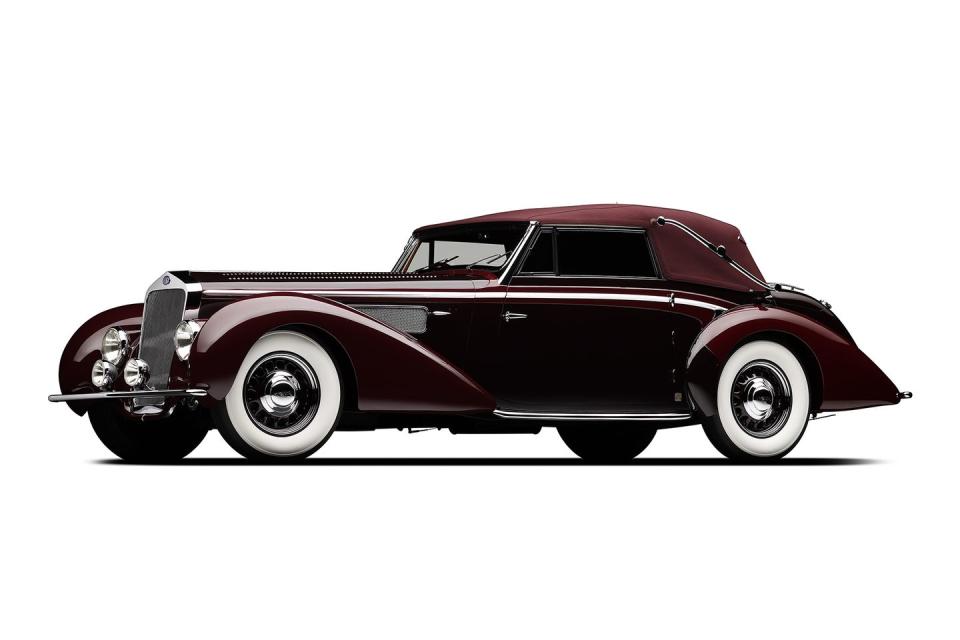
1931 Peugeot P 107 S 'Tour De France'—$4000 to $8000
While some may know that Peugeot once made bicycles, even fewer are familiar with Peugeot motorcycles. The company is actually known as Peugeot Motocycles, without the "r," and it is still in business making motorcycles. La Nouvelle Société des Cycles Peugeot had several well-received models by the early '30s. The 350-cc P 107 you see here featured the largest displacement single-cylinder engine that Peugeot made in 1931. This P 107 S was advertised as “Modèle Luxe,” and cost 4250 French francs when new. It was one of Peugeot’s most popular models at the time.
"A light and agile machine, the P 107 proved itself to be sporty and reliable and equally well suited for civilian and military use," Gooding says.
It is equipped with the then-high tech Marchal electric lights, which helped make the P 107 S a handsome machine ideal for city use and country touring. In military spec, the Peugeot P 107s were sometimes even used during the war to parachute behind enemy lines. This restored civilian model painted in military colors once formed part of a military display at the Dean Kruse Foundation in Indiana. Today, it is believed to be the only such example in the US. Imagine pulling up to The Quail Motorcycle Gathering on this.
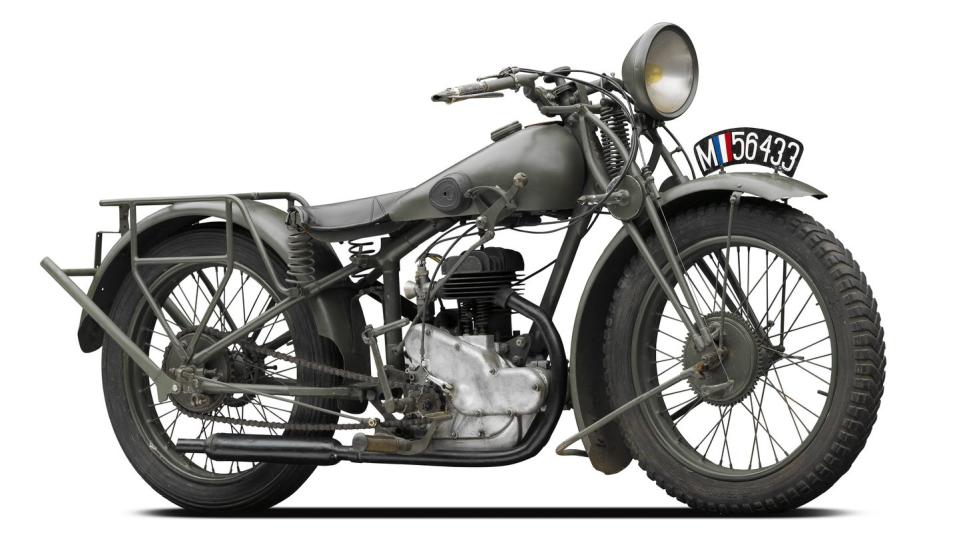
1960 Citroen ID19—$4000 to $8000
You may know the Citroen DS, the elegant French wagon that raised and lowered itself on hydropneumatic springs while looking elegant doing so. With its suave sophisticated approach to practicality, the only thing more French may have been Charles de Gaulle himself. This is the DS' less-expensive cousin, the Robespierre, if you will. This particular example is billed as a "restoration project." If you win the auction, may we suggest you take it directly to Marrs Automotive in Santa Clarita?
The DS from which the ID sprang, following on the taillights of the Traction Avant, was revolutionary for its day. Sporting a futuristic, aero-efficient body shell and fully independent self-levelling, hydropneumatic suspension, along with power brakes, clutch, and steering, the DS "was immediately successful and influential," Gooding says.
The DS debuted at the 1956 Paris Salon, and shortly thereafter the simplified ID19 version came along, at first without the interior and exterior trim of the DS and minus the comprehensive hydraulic power-assists of its sibling. Those features were gradually added to the more basic ID19 as production continued until 1969.
This particular ID19 was purchased by the Mullin Collection in 2015, with the goal of recreating the Citroën “Balloon Car,” the one featured in ads perched atop four balloons to emphasize its comfortable ride. The restoration was never done. It's not clear which mechanical parts are present. So go to the inspection day on Thursday before the Friday auction and get them to pop the hood.
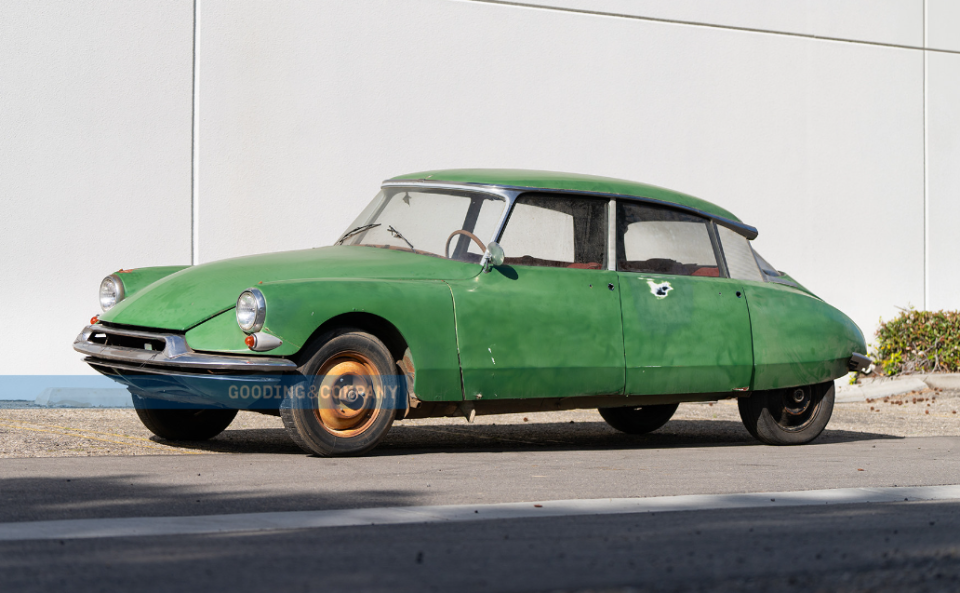
1934 Bugatti Type 57 Ventoux—$125,000 to $175,000
At the back of the Mullin Museum, behind a wall, was a row of unrestored—and unwashed—cars purchased from the Schlumpf Collection in Mulhouse, France. The Schlumpfs are an entirely 'nother story. They were wealthy brothers who amassed the largest collection of Bugattis ever assembled, only to find themselves chased away by workers from their mills into exile in Switzerland. This Type 57, and several other lots in the auction, is one of those Schlumpf Bugattis.
The Type 57 was introduced in 1934 and is widely regarded as Jean Bugatti's masterpiece. It's powered by the same "jewel-like 3.3-liter, twin-cam, straight-eight engine as the Type 57C Aravis 'Special Cabriolet' above.
According to the American Bugatti Register and Data Book, this Type 57 was delivered to its first owner, Jean Verdier, for 66,240 French francs. It made its way to the collection of John Shakespeare of Centralia, Illinois, who sold it and a number of other Bugattis to Fritz Schlumpf in 1964, where it became part of the infamous Schlumpf Reserve Collection.
Like several others, this Type 57 remained in static storage and unrestored in Malmerspach, France, until 2008 when Mullin purchased the entire collection, including this Bugatti. After acquiring the cars, the Mullin Collection kept approximately half of the Schlumpf Reserve Collection for display in the Mullin Automotive Museum, only exhibiting cars of particular historical significance. The Type 57 is one of these cars.
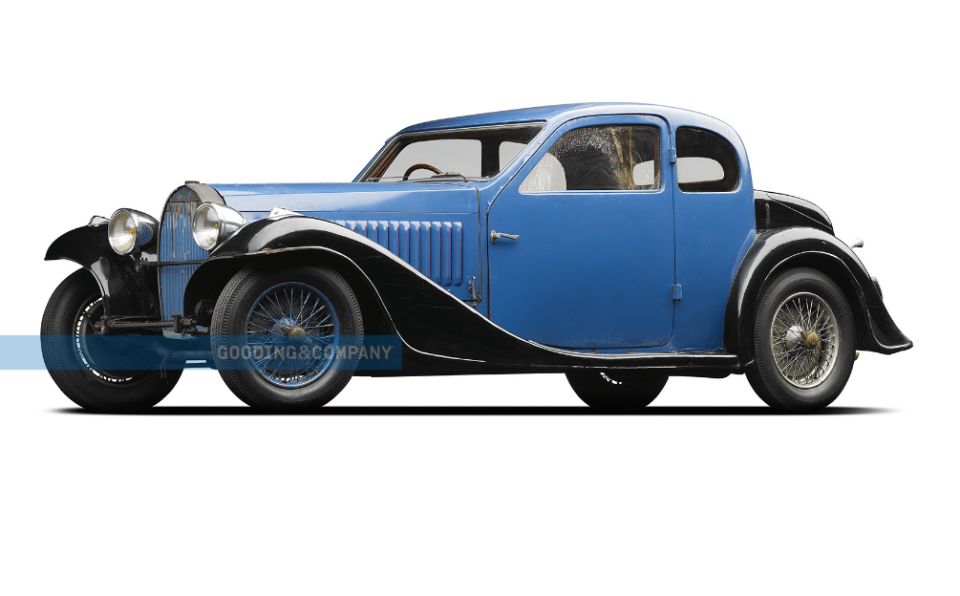
1973 Citroën HY78 Van—$30,000 to $50,000
Everybody has, at one time or another, imagined themselves buying an H van and starting a mobile crepery, flipping open the side awning and selling Crepes Suzette to delighted attendees of some sort of arts festival at which you would be a vendor. It's intriguing in the same way buying a sailboat or a race car is intriguing. You might even convince yourself it would be "profitable."
Well here's your H van!
Citroën developed and produced the first front-drive lightweight utility van prior to the outbreak of WWII in Europe. While only an estimated 2000 examples were built before the war, the TU-B inspired its postwar successor, the Type H, which debuted at the 1947 Paris Motor Show. Offered as a cab/chassis or complete body, the Type H Van was elegantly designed and immensely versatile, with form clearly following function, Gooding says. Based on a flat, load-bearing platform chassis, the proven mechanicals of the Type H Van utilized Citroën’s popular and ubiquitous Traction Avant engine, mostly in 56-hp 11CV specification with a three-speed manual transmission and front-wheel drive, plus such Citroën hallmarks as fully independent torsion-bar suspension. Vérifiez ce corrugated steel bodywork! The Type H Van had a 3300-pound payload capacity, enough for about a million crepes. The Type H was a commercial success, with 473,000 produced by the model’s retirement in 1981.
This one has already been outfitted as a mobile champagne vendor, so half your work's done for you. This HY78 from 1973 is "an engaging example of these fascinating and attractive French workhorses." Acquired by the Mullin Collection in 2015, it is accompanied by copies of prior French registration documents and a Citroën book excerpt covering the model.
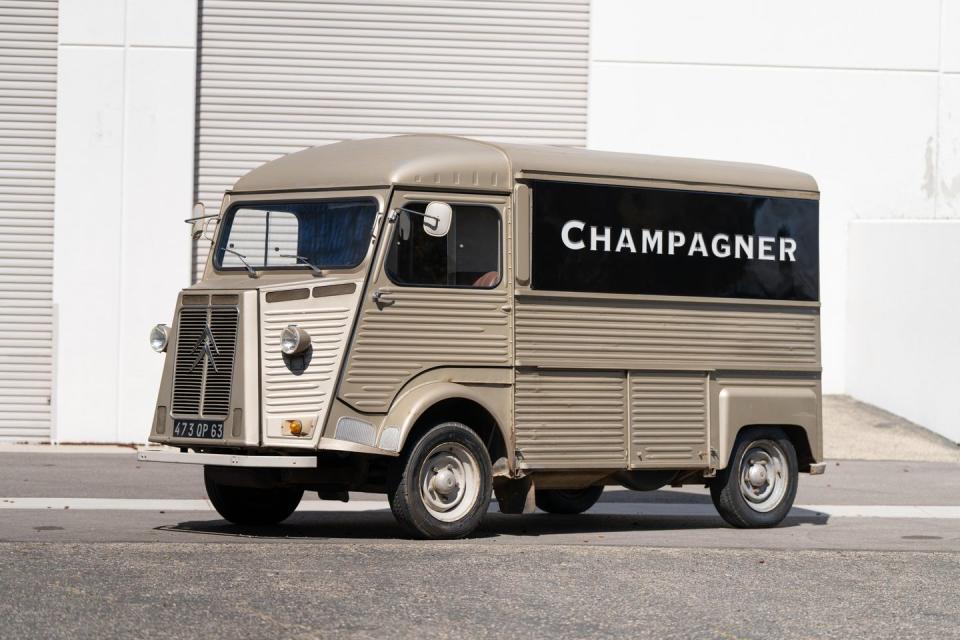
1964 Citroën Ami 6 Berline—$15,000 to $20,000
Full disclosure: I was checking prices on these only a few years ago, in pursuit of what I thought would be one of the coolest, yet still most affordable classic French cars ever made. The Gooding estimate of $15-20k is right in line with the prices I was seeing then.
Gooding says this: Launched in 1961 as the world’s most comfortable medium class car, the Citroën Ami 6 was styled by longtime Citroën engineer Flaminio Bertoni, who played leading roles in the design of such legends as the Traction Avant, 2CV, and DS. Featuring ultra-modern styling, the Ami 6 was offered in two main body styles—a berline or notchback sedan and the break (estate wagon), plus a van-style commerciale.
Underneath, the Ami 6 shared many mechanical components with the 2CV, including the platform chassis, all-independent suspension, boxer-style, air-cooled 602-cc two-cylinder engine, four-speed gearbox, and front-wheel-drive system. Production of the Ami 6 continued until 1969 and the advent of the updated Ami 8, which enjoyed production until 1978.
Interestingly, Citroën considered the Ami so characteristically “Citroën” in nature that it deemed identification badges superfluous. Highly practical and easy to drive, Citroën’s marketing efforts promoting the Ami were directed mainly to women buyers.
Acquired in the Netherlands by the Mullin Collection in 2015, this 1964 Citroën Ami 6 Berline is a very nice example of these user-friendly and successful French motorcars. Finished in two-tone livery comprising a white upper roof surface and blue main body, this Ami 6 is equipped with a useful roof rack and complemented by white-painted steel wheels. Inside, the driver is greeted by Citroën’s fabulously modernistic single-spoke steering wheel and dash-mounted gearshift.
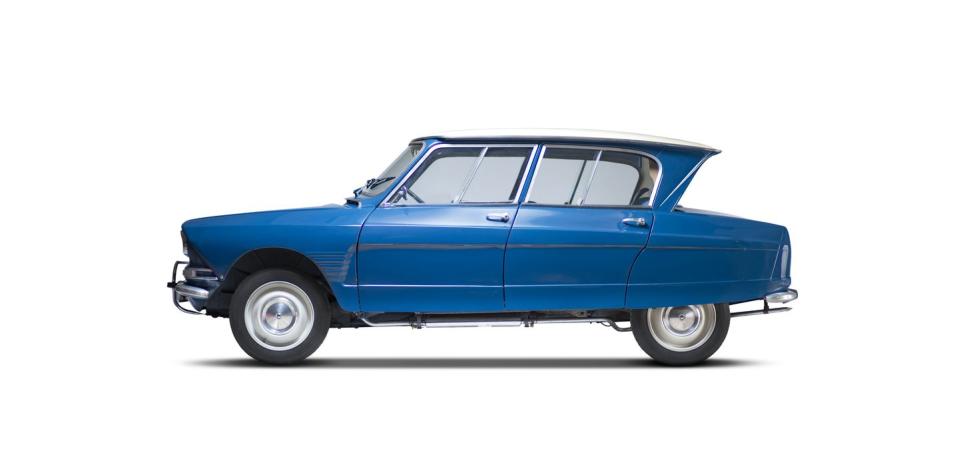
2009 Citroën C3 Pluriel 1.4i Charleston—$8000 to $12,000
There's nothing in Gooding's description of this cute little Euro-hatch about whether—and even if—you could ever register it. It's not 25 years or older so you can't go that route. How did Peter Mullin even get it in the country? Maybe you could just register it as a Daewoo? It is "accompanied by copies of correspondence and prior Dutch registration papers," so tell the DMV clerk that, in a French, or Dutch, accent.
Gooding does say the car is "A charming and attractive example of Citroën’s continued homage to the legendary and incredibly successful 2CV and its many variants." Now enjoying its fourth generation in production, Citroën’s C3 “supermini” car replaced the Saxo and entered production in April 2002.
Initially a practical five-door hatchback, the design was also marketed as the premium level DS3. The innovative Pluriel debuted in July 2003, adding a unique, multi-configuration convertible to the C3 model line. More than worthy of its “Pluriel” moniker (meaning “Plural”), the new C3 featured a multi-mode convertible top, allowing the car to be configured at will from the standard hatchback to a sunroof saloon, a convertible with the roof lowered, a full convertible with upper roof pillars detached, or even a roadster pickup with the top fully retracted and the rear seat folded down. A distinctive side treatment recalled the popular and beloved 2CV Charlestons of the 1980s, adding to the usability and considerable fun factor delivered by the C3 Pluriel.
This C3 Pluriel from 2009 hails from the last model year for the first generation of production. It was purchased by the Mullin Collection from Europe in 2015.
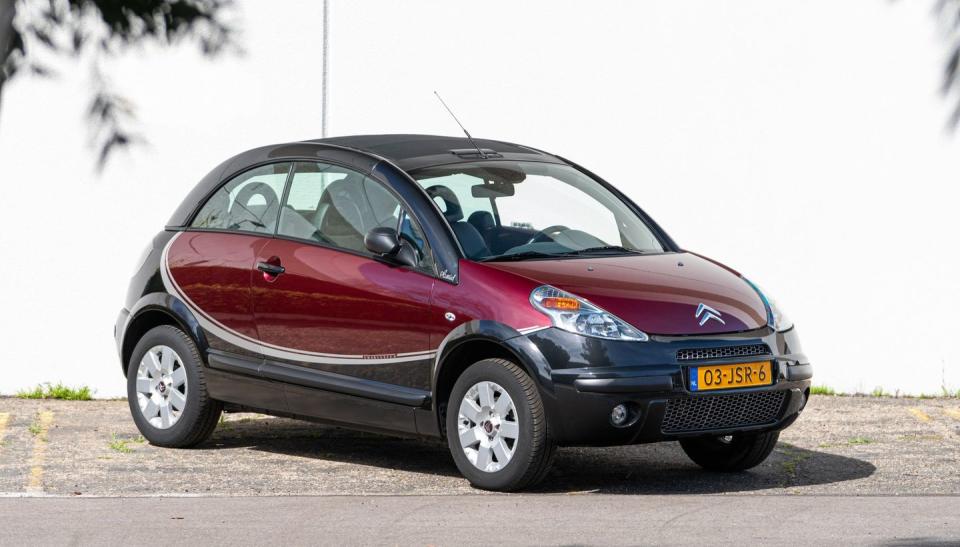
1928 Avions Voisin Type C28 Recreation—$30,000 to $50,000
Imagine this: For the price of a well-equipped Toyota Camry you could get a Voisin! Assuming it runs and you could get it started, you could be rollin' in tha deep in a car Pebble Beach entrants would admire. You could start wearing bow ties and using three- and four-syllable words! No one needs to know that it's a "recreation."
Yes, this is not a real Voisin, it just looks like it. This "evocation" of a Voisin Type C28 was created as a movie prop for use in the filming of Sahara, starring Matthew McConaughey and Penélope Cruz. Based on a novel by best-selling author Clive Cussler, the film was a continuation of his "Dirk Pitt" action stories. Cussler was a noted car enthusiast, and it is believed that his real Voisin may have inspired this recreation. The car was built by the film’s picture vehicle coordinator, Steve Lamonby, on a custom 4WD chassis and is powered by a 4.2-litre Jaguar engine through a Rover transmission. What could possibly go wrong with that notoriously reliable combination?
Its patinated finish is festooned with details from its use, including faux bullet holes. The Voisin Cocotte radiator mascot was even replicated, showing an attention to detail uncommon on vehicles of this type.
Nonetheless, there are Jaguar mechanics all over the place, many named Nigel, who actually know what they're doing. This thing would be ultra-cool to cruise around in. Imagine going to Vons or Kroger in this. Or just driving around the Monterey Peninsula or Amelia or Greenwich on Concours weekend. Ya know, I might just try to gather up some cash. Maybe a GoFundMe campaign?
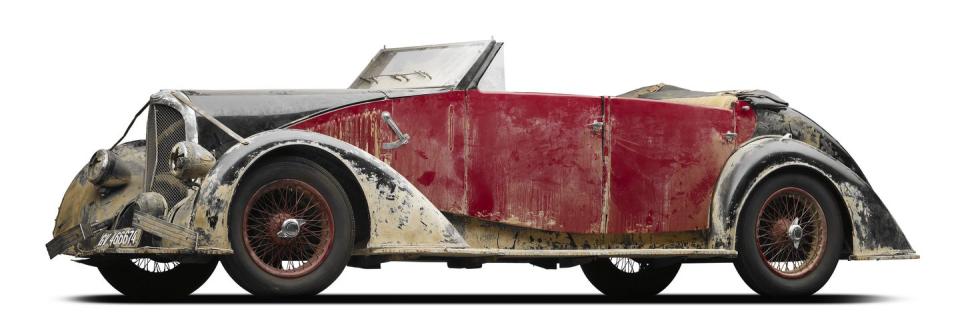
1933 Hispano-Suiza J12 Cabriolet—$2.5 to $3.5 Million
Okay, back to legit, world-beater cars. Hispano-Suiza—and this is a real one, not a recreation—is truly among the greatest cars in the world. Popularized by King Alfonso XIII of Spain, who loved his Hispano-Suizas as sports cars. The marque was founded in 1904 as an automobile manufacturer and eventually had several factories in Spain and France that produced luxury cars, aircraft engines, trucks, and weapons. But it's the luxury cars that have remained popular even today, and there is a company that made 19 Hispano-Suiza Carmen electric cars just recently, and plans to make more.
But in the early '30s these were da bomb.
"The firm’s crowning achievement was the truly magnificent J12, an automobile whose chassis offered unparalleled power, performance, and prestige," Gooding says. "Complementing that mechanical brilliance was coachwork produced by the finest coachbuilders, including Saoutchik, Million-Guiet, Fernandez et Darrin, and Vanvooren, among others." A 9.4-liter V12 launched the car down the road "with a trace of arrogance,” something that may be missing in today's automobiles.
This one is wrapped in Vanvooren coachwork. Restored under the care of then-owner John Mozart, it won its class at Pebble. When Mr. Mullin got the car, at least from our reading of the Gooding description, it won its class two more times at Pebble. “As one of about 114 J12s originally built, this magnificent Hispano-Suiza showcases the engineering brilliance of Marc Birkigt’s magnum opus chassis, and features a world-class restoration that has mellowed only slightly. Welcome at any deserving concours, it is certain to be revered for all the qualities Hispano-Suiza advertising promised: 'Speed, Security, Comfort, Silence and Elegance.'”
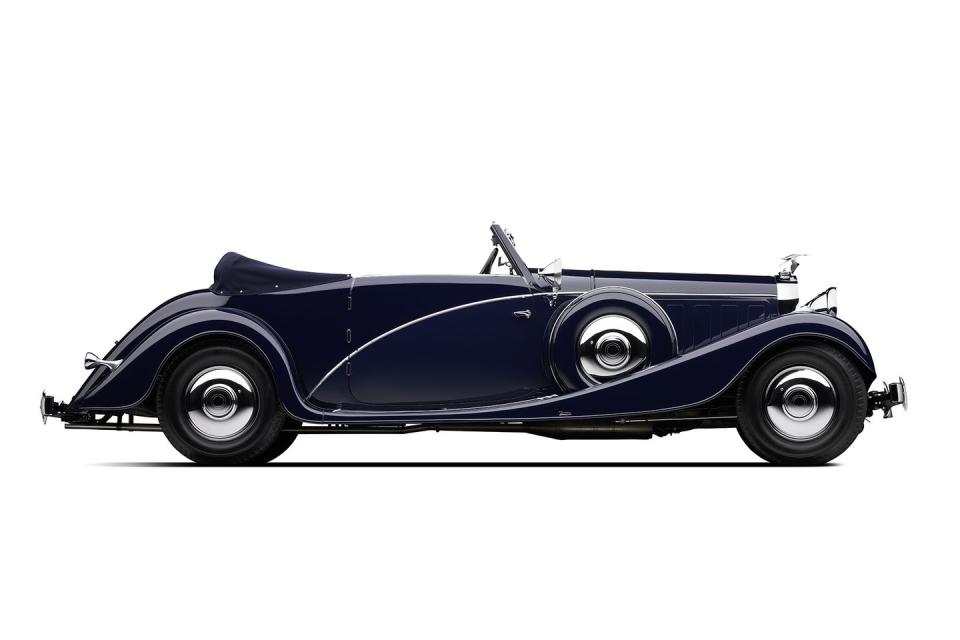
1930 Bugatti Type 46 Semi-Profilée Coupe—$700,000 to $900,000
The Type 46 was the second-largest Bugatti ever made, after the Bugatti Royale, and thus became known as "Le Petite Royale" among owners and Bugattisti. Others, citing the model's high production number of 430, called it "The Molsheim Buick." Kids can be so cruel.
Powered by a NOS (new old stock) 5.4-liter, SOHC straight-eight with three valves per cylinder making 140 hp, it's sometimes referred to as the last new Bugatti engine from the period, as later models used evolutions of earlier designs. It has a three-speed manual transaxle from another Bugatti built in unit with the rear axle. The "Semi Profilée" bodywork is also a recreation, if a good one.
But altogether, Gooding assures, it has "impeccable road manners due to the innate flexibility of the drivetrain." So if you do wind up buying this, it'll be fun to drive.
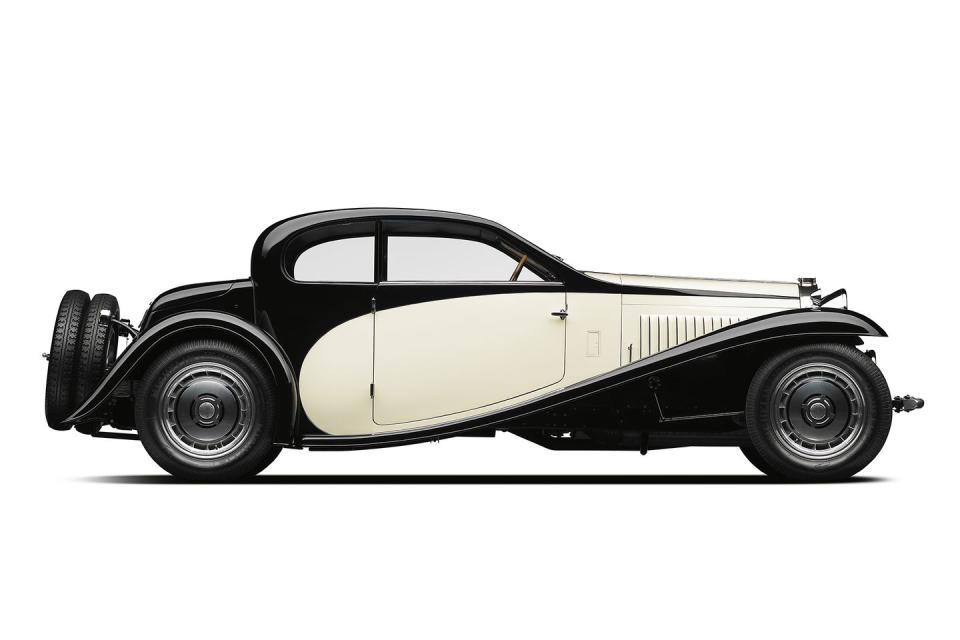
1973 Citroën SM—$30,000 to $40,000
Nothing says '70s like a Citroen SM. If you loved that decade, and you love France (Vive La France!) then you have to buy this car. No less an automotive design luminary than Stewart Reed, chairman emeritus of transportation design at Art Center, has had several. Everybody loves the SM.
It followed the highly successful DS in Citroen history, and since Citroen had purchased Maserati, the SM got a Maserati V6. CAR Magazine in 1972 said the SM provided a combination of comfort, sharp handling, and braking not available in any other car at the time. Hemmings said it gave you the ability to travel for hours at 200 km/h (124 mph) in comfort. Even Motor Trend gave it the Car of the Year Award.
For its part, Gooding calls it "one of the most daring and coveted grand touring automobiles ever produced." Have you driven one? Add your thoughts in the comments.
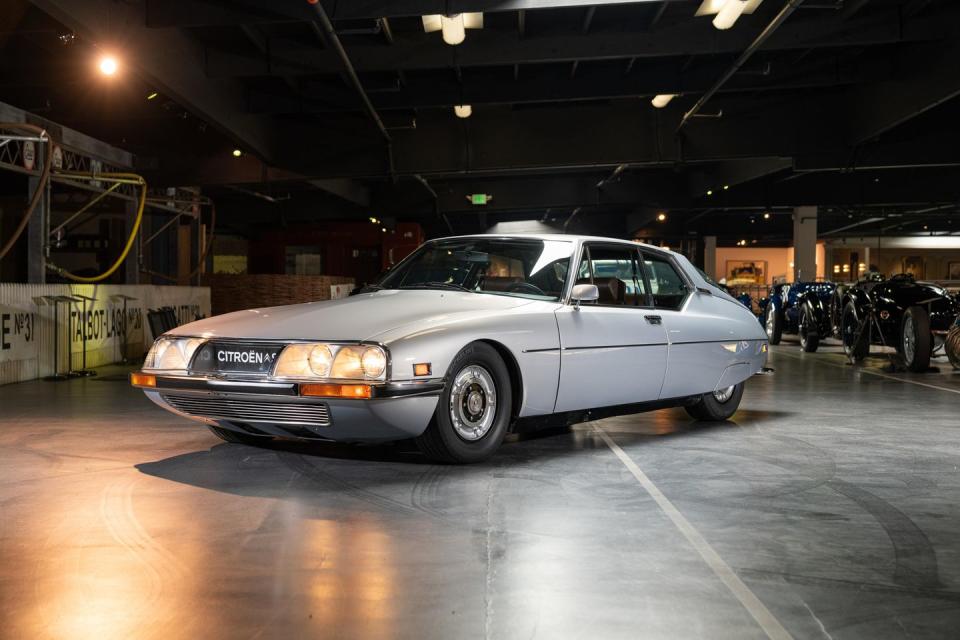
1925 Altos Moto Derny Type 15—$5000 to $10,000
The French called one of the 1950s Cadillac entries at Le Mans "Le Monstre," because of its grotesque new body aimed at cheating the wind. But they could just as easily have applied that moniker to this thing. What is it? Why is it?
This is another aquisition from the Schlumpf Collection. It's a motorcycle built for setting speed records via streamlining. The Altos Moto Derny Type 15 (what did the other 14 look like?) employed "innovative methods of shielding the record challenger from headwinds," according to Gooding. That's an understatement. There was a lot of innovation going on in motorcycle racing in the 1920s.
Gooding: "Before long, two-wheeled vehicles were built expressly for this purpose, placing the motorcycle’s pilot as far rearward as possible, giving the cyclist, or 'stayer,' the greatest benefit of his slipstream. This four-cylinder motorcycle was constructed by Altos circa 1925 and, according to notes on file, was used in the establishment of a speed record of 120.958 kph (75 mph) by successful French cyclist Jean Brunier on November 1, 1925, at the Velodrome at Montlhéry in France. To attain this speed, the vehicle was specially clad with aerodynamic aluminum panels and fitted with an extended handlebar setup, allowing the pilot to control it from a near-standing position."
That must've been fun. Or dangerous. But you have to wonder whether it'll meet its $5-10k hammer estimate.
